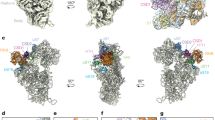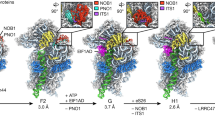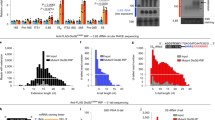Abstract
Eri1 is a 3′-to-5′ exoribonuclease conserved from fission yeast to humans. Here we show that Eri1 associates with ribosomes and ribosomal RNA (rRNA). Ribosomes from Eri1–deficient mice contain 5.8S rRNA that is aberrantly extended at its 3′ end, and Eri1, but not a catalytically inactive mutant, converts this abnormal 5.8S rRNA to the wild-type form in vitro and in cells. In human and murine cells, Eri1 localizes to the cytoplasm and nucleus, with enrichment in the nucleolus, the site of preribosome biogenesis. RNA binding residues in the Eri1 SAP and linker domains promote stable association with rRNA and thereby facilitate 5.8S rRNA 3′ end processing. Taken together, our findings indicate that Eri1 catalyzes the final trimming step in 5.8S rRNA processing, functionally and spatially connecting this regulator of RNAi with the basal translation machinery.
This is a preview of subscription content, access via your institution
Access options
Subscribe to this journal
Receive 12 print issues and online access
$189.00 per year
only $15.75 per issue
Buy this article
- Purchase on Springer Link
- Instant access to full article PDF
Prices may be subject to local taxes which are calculated during checkout





Similar content being viewed by others
References
Kennedy, S., Wang, D. & Ruvkun, G. A conserved siRNA-degrading RNase negatively regulates RNA interference in C. elegans. Nature 427, 645–649 (2004).
Buhler, M., Mohn, F., Stalder, L. & Muhlemann, O. Transcriptional silencing of nonsense codon-containing immunoglobulin minigenes. Mol. Cell 18, 307–317 (2005).
Buhler, M., Verdel, A. & Moazed, D. Tethering RITS to a nascent transcript initiates RNAi- and heterochromatin-dependent gene silencing. Cell 125, 873–886 (2006).
Iida, T., Kawaguchi, R. & Nakayama, J. Conserved ribonuclease, Eri1, negatively regulates heterochromatin assembly in fission yeast. Curr. Biol. 16, 1459–1464 (2006).
Cheng, Y. & Patel, D.J. Crystallographic structure of the nuclease domain of 3′hExo, a DEDDh family member, bound to rAMP. J. Mol. Biol. 343, 305–312 (2004).
Dominski, Z., Yang, X.C., Kaygun, H., Dadlez, M. & Marzluff, W.F. A 3′ exonuclease that specifically interacts with the 3′ end of histone mRNA. Mol. Cell 12, 295–305 (2003).
Timmons, L. Endogenous inhibitors of RNA interference in Caenorhabditis elegans. Bioessays 26, 715–718 (2004).
Duchaine, T.F. et al. Functional proteomics reveals the biochemical niche of C. elegans DCR-1 in multiple small-RNA-mediated pathways. Cell 124, 343–354 (2006).
Lee, R.C., Hammell, C.M. & Ambros, V. Interacting endogenous and exogenous RNAi pathways in Caenorhabditis elegans. RNA 12, 589–597 (2006).
Gabel, H.W. & Ruvkun, G. The exonuclease ERI-1 has a conserved dual role in 5.8S rRNA processing and RNAi. Nat. Struct. Mol. Biol. advance online publication, doi:10.1038/nsmb.1411 (27 April 2008).
Yang, X.C., Purdy, M., Marzluff, W.F. & Dominski, Z. Characterization of 3′hExo, a 3′ exonuclease specifically interacting with the 3′ end of histone mRNA. J. Biol. Chem. 281, 30447–30454 (2006).
Moore, P.B. & Steitz, T.A. The involvement of RNA in ribosome function. Nature 418, 229–235 (2002).
Lecompte, O., Ripp, R., Thierry, J.C., Moras, D. & Poch, O. Comparative analysis of ribosomal proteins in complete genomes: an example of reductive evolution at the domain scale. Nucleic Acids Res. 30, 5382–5390 (2002).
Cote, C.A., Greer, C.L. & Peculis, B.A. Dynamic conformational model for the role of ITS2 in pre-rRNA processing in yeast. RNA 8, 786–797 (2002).
Joseph, N., Krauskopf, E., Vera, M.I. & Michot, B. Ribosomal internal transcribed spacer 2 (ITS2) exhibits a common core of secondary structure in vertebrates and yeast. Nucleic Acids Res. 27, 4533–4540 (1999).
Yeh, L.C. & Lee, J.C. Structural analysis of the internal transcribed spacer 2 of the precursor ribosomal RNA from Saccharomyces cerevisiae. J. Mol. Biol. 211, 699–712 (1990).
Chen, F.W. & Ioannou, Y.A. Ribosomal proteins in cell proliferation and apoptosis. Int. Rev. Immunol. 18, 429–448 (1999).
Lambertsson, A. The minute genes in Drosophila and their molecular functions. Adv. Genet. 38, 69–134 (1998).
Fukuda, T. et al. DEAD-box RNA helicase subunits of the Drosha complex are required for processing of rRNA and a subset of microRNAs. Nat. Cell Biol. 9, 604–611 (2007).
Oliver, E.R., Saunders, T.L., Tarle, S.A. & Glaser, T. Ribosomal protein L24 defect in belly spot and tail (Bst), a mouse Minute. Development 131, 3907–3920 (2004).
Draptchinskaia, N. et al. The gene encoding ribosomal protein S19 is mutated in Diamond-Blackfan anaemia. Nat. Genet. 21, 169–175 (1999).
Fatica, A. & Tollervey, D. Making ribosomes. Curr. Opin. Cell Biol. 14, 313–318 (2002).
Pillai, R.S. et al. Inhibition of translational initiation by Let-7 microRNA in human cells. Science 309, 1573–1576 (2005).
Thermann, R. & Hentze, M.W. Drosophila miR2 induces pseudo-polysomes and inhibits translation initiation. Nature 447, 875–878 (2007).
Faber, A.W., Van Dijk, M., Raue, H.A. & Vos, J.C. Ngl2p is a Ccr4p-like RNA nuclease essential for the final step in 3′-end processing of 5.8S rRNA in Saccharomyces cerevisiae. RNA 8, 1095–1101 (2002).
Mitchell, P., Petfalski, E., Shevchenko, A., Mann, M. & Tollervey, D. The exosome: a conserved eukaryotic RNA processing complex containing multiple 3′ → 5′ exoribonucleases. Cell 91, 457–466 (1997).
Allmang, C. et al. The yeast exosome and human PM-Scl are related complexes of 3′ → 5′ exonucleases. Genes Dev. 13, 2148–2158 (1999).
Briggs, M.W., Burkard, K.T. & Butler, J.S. Rrp6p, the yeast homologue of the human PM-Scl 100-kDa autoantigen, is essential for efficient 5.8 S rRNA 3′ end formation. J. Biol. Chem. 273, 13255–13263 (1998).
van Hoof, A., Lennertz, P. & Parker, R. Three conserved members of the RNase D family have unique and overlapping functions in the processing of 5S, 5.8S, U4, U5, RNase MRP and RNase P RNAs in yeast. EMBO J. 19, 1357–1365 (2000).
Denli, A.M., Tops, B.B., Plasterk, R.H., Ketting, R.F. & Hannon, G.J. Processing of primary microRNAs by the Microprocessor complex. Nature 432, 231–235 (2004).
Gregory, R.I. et al. The Microprocessor complex mediates the genesis of microRNAs. Nature 432, 235–240 (2004).
Wu, H., Xu, H., Miraglia, L.J. & Crooke, S.T. Human RNase III is a 160-kDa protein involved in preribosomal RNA processing. J. Biol. Chem. 275, 36957–36965 (2000).
Jalal, C., Uhlmann-Schiffler, H. & Stahl, H. Redundant role of DEAD box proteins p68 (Ddx5) and p72/p82 (Ddx17) in ribosome biogenesis and cell proliferation. Nucleic Acids Res. 35, 3590–3601 (2007).
Lau, N.C., Lim, L.P., Weinstein, E.G. & Bartel, D.P. An abundant class of tiny RNAs with probable regulatory roles in Caenorhabditis elegans. Science 294, 858–862 (2001).
Acknowledgements
We wish to thank W. Hammerschmidt, Helmholtz Center Munich, for the gift of the SV40 large T hygro retrovirus, D. Eick, Helmholtz Center Munich, for the gift of anti–PES-1 antibody and F. Alt, Immune Disease Institute, Boston, for recombinant Cre adenovirus. We thank J. Asara for assistance with MS and data analysis, E. Yanni and C. Gelinas for technical assistance and A. Whynot, T.A. Rapoport and P. Sorger for help and equipment for gradient fractionation. We also thank H. Gabel and G. Ruvkun for communicating unpublished data, the laboratories of D. Eick, M. Meisterernst and I. Jeremias for helpful discussion, and D. Eick and D. Moazed for comments on the manuscript. This work was supported by US National Institutes of Health (NIH) grants AI44432 and AI70788 to A.R., a Cancer Research Institute fellowship and Deutsche Forschungsgemeinschaft grant HE 3359/2 to V.H., and a Burroughs Wellcome Fund Career Award in the Biomedical Sciences to K.M.A. K.M.A. is a Special Fellow of The Leukemia and Lymphoma Society. W.A.P. is a National Defense Science and Engineering Graduate fellow. M.T. is supported by the Harvard Stem Cell Institute and is a Predoctoral Fellow of the Ryan Foundation.
Author information
Authors and Affiliations
Contributions
K.M.A. and V.H. initiated the project, planned and supervised the experiments, performed some experiments, and wrote the manuscript. A.R. provided advice and support and edited the manuscript. W.A.P., N.R. and A.D.L. established tools and assays and performed and analyzed experiments with technical assistance and advice from E.G., C.W., L.C.S., N.P., E.D.L., M.T., J.W.E. and Y.S. The monoclonal anti-Eri1 antibody was generated by E.K.
Corresponding authors
Supplementary information
Supplementary Text and Figures
Supplementary Figures 1–7, Supplementary Tables 1 and 2 and Supplementary Methods (PDF 5208 kb)
Rights and permissions
About this article
Cite this article
Ansel, K., Pastor, W., Rath, N. et al. Mouse Eri1 interacts with the ribosome and catalyzes 5.8S rRNA processing. Nat Struct Mol Biol 15, 523–530 (2008). https://doi.org/10.1038/nsmb.1417
Received:
Accepted:
Published:
Issue Date:
DOI: https://doi.org/10.1038/nsmb.1417
This article is cited by
-
ISG20L2: an RNA nuclease regulating T cell activation
Cellular and Molecular Life Sciences (2023)
-
Exonuclease requirements for mammalian ribosomal RNA biogenesis and surveillance
Nature Structural & Molecular Biology (2019)
-
Reserpine requires the D2-type receptor, dop-3, and the exoribonuclease, eri-1, to extend the lifespan in C. elegans
Journal of Biosciences (2016)
-
Cleavage of roquin and regnase-1 by the paracaspase MALT1 releases their cooperatively repressed targets to promote TH17 differentiation
Nature Immunology (2014)
-
Eri1 degrades the stem-loop of oligouridylated histone mRNAs to induce replication-dependent decay
Nature Structural & Molecular Biology (2013)



